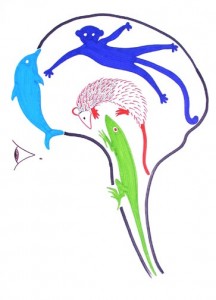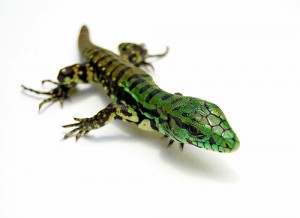The “lizard brain”, or Reptilian Brain (amygdala), controls the most instinctive behavior of the human being. It controls (emotional) learning behaviors: impulse reactions, avoidance tactics, predictive knowledge. And so, consequently, it actually controls learning behaviors around brands and products too! When a consumer sees a new pack, a new product, a car, etc but can not access it immediately, they need to rely on the lizard brain to try to IMAGINE, to try to PREDICT what the product quality and benefits of the product would be. (That seems pretty much the same “learning process” as how a rat can “predict” that a light impulse will be followed by food in a lab experiment). Consumers use all cognitive elements possible for fast “decoding” so they can make fast decisions. That also helps overcome decision fatigue -with hundreds of decisions to be made every day, the faster one can go through it, the better.
learn about the lizard brain in this simple but entertaining video:
I find this utterly fascinating…
Those first 30″ are E-V-E-R-Y-T-H-I-N-G
The lizard brain teaches us that that instant moment, that “blink” moment is indeed… everything. Forget digging deeper and deeper and deeper in your consumers brains in research interviews. What you want is a research agency that knows perfectly well how to capture the first seconds and first minutes of associations that consumers make when they are confronted with your new campaign, your packaging, the taste of your product, and how to make that actionable and accessible. All the rest (of the interview time and deep-drilling analysis) is “mental masturbation”, excuse my French. Then, once you have those snapshot thoughts and motivations nailed down, the job at hand is to act accordingly: design your whole value proposition around those finite 30 seconds of truth!
What do you do with that as a marketer?
On the “positive” side, leveraging how the lizard brain works:
>> Listen to your gutfeel!
>> Give your consumers all possible signals to make sure they can accurately “predict” what they will get: packaging cues, colors, smell, physical attributes, communication/education, etc. And make the decoding so easy that a child can understand it. You need to capture those first 30 seconds!
On the “negative” side, overcoming the lizard brain, working around it:
>> Give your consumers a sample, so they don’t have to guess! It’s really as simple as that. And importantly : tell stories! Here’s an interesting presentation that establishes the link between the brain functions and storytelling:
I’m obviously not a psychologist or psychiatrist that can explain the fundamentals of how the reptile brain works in shopper or consumption environment, but I would LOVE to learn. Anyone out there with a good understand of this? Please share references, sites, etc with the world > please do react to this post!








{ 3 comments… read them below or add one }
The science behind marketing techniques always fascinates me, too. I do think the “deep drilling” does work, too–just not on the lizard brain! Appreciate your highlighting this, Kurt.
thanks!
stay in touch.
http://blog.ogilvychww.com/2012/03/13/emotional-branding-theres-a-lizard-in-your-brain/